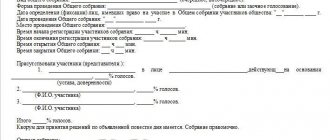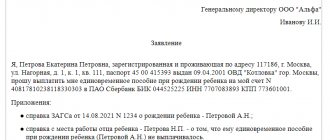Prerequisites for dividend payments
Dividends (part or the entire amount of net profit) are paid to shareholders (in a JSC) or participants (in an LLC) at quarterly, semi-annual or annual intervals according to a decision made by the general meeting of the company. The adoption of such a decision and its subsequent execution are possible subject to the following conditions (letter of the Ministry of Finance of the Russian Federation dated September 20, 2010 No. 03-11-06/2/147, Article 43 of the Law “On Joint-Stock Companies” dated December 26, 1995 No. 208-FZ and Art. 29 of the Law “On LLC” dated 02/08/1998 No. 14-FZ):
- according to the accounting data for the payment period, there is a net profit;
- The management company has been paid in full;
- the amount of net assets exceeds the sum of the charter capital and the reserve fund (and for a joint-stock company also the amount of the excess of the value of preferred shares over the par value), and this ratio will not change after the issuance of dividends;
- there are no signs of bankruptcy, and they will not appear after the payment of dividends;
- the repurchase of shares was completed according to the existing requirements of shareholders - for JSC;
- the withdrawing participant is fully paid his share - for an LLC;
- the necessary sequence is observed in determining payments: first for preferred shares with advantages, then for other preferred shares and finally - for ordinary shares for the joint-stock company.
The meeting, making a decision on payment and documenting it in minutes, establishes the following:
- the amount intended for payment;
- form and timing of funds issuance;
- the amount of payments for each type of shares - in the joint-stock company;
- the date on which the list of shareholders will be compiled - in the joint-stock company.
Based on these data, the amounts allocated to each participant are determined depending on:
- the type and number of shares he has - in the joint-stock company;
- the size of his share (if there is no other distribution formula in the charter) - in an LLC.
If a legal entity has a single participant, the minutes of the meeting replace its sole decision.
The preferred form of issuance is cash, because the permitted property form is equated to sale (letter of the Ministry of Finance of the Russian Federation dated December 17, 2009 No. 03-11-09/405) and is extremely unprofitable from a taxation perspective.
The issuance period should not exceed:
- in JSC - 10 (for nominal holders and trustees) and 25 (for other shareholders) working days from the date on which the list of shareholders was compiled;
- in LLC - 60 days from the date of the decision.
If for some reason a participant has not received his share on time, then he has the opportunity to demand payment within 3 years (or 5 years if specified in the charter) from the date:
- decision-making - in the joint-stock company;
- completion of the 60-day period - in an LLC.
After a 3- or 5-year period, unclaimed amounts are returned to the legal entity’s net profit.
Dividends in the Statement of Financial Results (FRS)
The size of dividends paid is not reflected in the FFR, since it provides data on income received, expenses incurred from the beginning of the year to the reporting date and the financial result formed for the reporting period - profit or loss. Dividends are a category that does not fall under the concept of profit, since they are paid out of it, and it is impossible to see the specific number of dividend payments made and issued to participants or shareholders in the financial market. Moreover, this does not depend on the category of recipients. It is also impossible to determine the founder’s dividends in the “Report on Financial Results”.
Example
Based on the relevant orders of the director, throughout the year Iris JSC paid quarterly dividends to the individual founder, the total amount of which was 400,000 rubles. The company's net profit for the year is RUB 1,000,000. After payment of dividends, its size amounted to 600,000 rubles. (1,000,000 – 400,000). It is this amount that will appear in line 2400 of the financial statement, and the user will be able to find out what the amount of dividends was from the explanatory note attached to the financial statements. In addition, data on the amount of payments is reflected in forms 2-NDFL, 6-NDFL, since income tax is necessarily levied on payments transferred to individuals.
If, by order of the manager, the company has established a procedure for issuing dividends based on the results of the year, then the payment to the founder will be made in the new year, i.e., after the end of the reporting period. In this case, the payment of dividends will not be reflected in the company's annual reporting - it will be a decrease in capital in liabilities and cash in assets, but only in the balance sheet of the next year. Accordingly, line 2400 of the financial reporting period for the reporting year will indicate the amount of profit not reduced by the amount of dividends - 1,000,000 rubles. (according to the example conditions).
Dividends are a position that reduces the company's capital, so their amount is indicated in another form - the “Statement of Changes in Equity” (line 3327), and the actual payment made is reflected in the statement of “Cash Flows” (line 4322), of course, if the issue dividends were paid in the reporting period.
Tax calculation
Based on the minutes of the meeting (or the decision of the participant), the head of the legal entity issues an order for payment. It will already contain the amounts due to each recipient. When calculating them, it is advisable to immediately determine the amounts of withholding taxes, for the payment of which an extremely limited time is allotted (no later than the first business day following the day of payment of dividends):
- for personal income tax (payments to individuals) - according to clause 6 of Art. 226 Tax Code of the Russian Federation;
- for income tax (payments to legal entities) - clause 4 of Art. 287 Tax Code of the Russian Federation.
Taxes on payments made in 2020-2021 are calculated at the following rates:
- Personal income tax - 13% (clause 1 of Article 224 of the Tax Code of the Russian Federation) for individuals with Russian citizenship, and 15% (clause 3 of Article 224 of the Tax Code of the Russian Federation) for foreign citizens and citizens of the Russian Federation when paying dividends in the amount of 5 million rubles. and higher;
You can learn how to reflect the payment of dividends in the 6-NDFL and 2-NDFL reports from the Ready-made solution from ConsultantPlus. Get temporary access to the legal reference system. It's free.
- income tax - 13% (subclause 2, clause 3, article 284 of the Tax Code of the Russian Federation) for companies established in the Russian Federation, and 15% (subclause 3, clause 3, article 284 of the Tax Code of the Russian Federation) for legal entities of foreign origin; when calculating tax on a legal entity that has owned more than half the share in the capital of the dividend payer for at least a year, a 0% rate can be applied (subclause 1, clause 3, article 284 of the Tax Code of the Russian Federation).
Everything about the calculation and payment of income tax when paying dividends is described in the analytical material of ConsultantPlus. And filling out the income tax return when paying dividends is discussed in the Ready-made solution from ConsultantPlus. Having received free trial access to the legal reference system, you can study any issue.
When the legal entity paying dividends is also the recipient, the tax paid by residents can be reduced by reducing the overall tax base (the total amount of dividends allocated for distribution). The amount accepted for offset is calculated in a new way starting from 2021. How exactly, see here.
For more information about calculating tax on dividends, read the article “How to correctly calculate tax on dividends?” .
Dividend distribution
If there is a single founder, the issue of distribution does not arise. He receives the entire amount allocated for payment purposes.
If there are several participants, the distribution will most often be proportional to the share of the contribution to the management company. The amount of dividends per person is determined by multiplying the total amount allocated for distribution by the percentage reflecting the share of participation.
If the distribution does not correspond to the proportion or algorithm established by the charter, then in relation to payments to individuals this may lead to disputes with extra-budgetary funds, which are not accrued on the amount of legally paid dividends. And the amounts in excess will be considered ordinary income, for which these accruals are required.
What to pay attention to when distributing the net profit of an enterprise, read the article “What is the procedure for distributing net profit (nuances)?”
Calculation of dividends to founders: postings from the payer
The accrual of dividends by entries in the accounting of the person paying the dividends must be made on the date when the meeting of shareholders (participants) decided to pay them. Accounting for settlements with founders is kept on account 75, if the founder is not an employee of the enterprise, or on account 70, if the founder and director are the same person.
The entries associated with the accrual of dividends will be as follows:
- Dividends were accrued to the founders (posting as of the date of the decision with a breakdown in the analytics of accounts 70 and 75 by participants): Dt 84 Kt 75 - for participants-legal entities and individuals who do not work for the dividend payer;
- Dt 84 Kt 70 - for individual participants who are employees of the dividend payer.
- Dt 75 Kt 68 - for participants-legal entities (income tax) and individuals who do not work for the dividend payer (personal income tax);
- Dt 75 Kt 51 (50) - to participants-legal entities and individuals who do not work for the dividend payer;
- Dt 68 Kt 51 - broken down by type of tax (profit or personal income tax).
- Dt 75 Kt 84 - listed on account 75.
To learn how account 84 is reflected in the balance sheet, read the article “Procedure for compiling a balance sheet (example).”
Source of LLC dividends
Dividends (or income from the use of net profit) are income the receipt of which is available to LLC participants (Clause 1, Article 28 of the Law “On LLC” dated 02/08/1998 No. 14-FZ).
Accordingly, to issue such income, it is necessary, first of all, to have net profit. It is determined according to accounting data (letter of the Ministry of Finance of the Russian Federation dated September 20, 2010 No. 03-11-06/2/147). The LLC has the opportunity to choose the frequency of dividend payments to the founders: quarterly, half-yearly or annually - depending on the amount of net profit for each of these periods. Considering that profit is considered an accrual total for the year, its final amount will be known at the end of the reporting period, and only then will it be possible to establish the final amount of income possible for payment. Therefore, in order to avoid situations where dividends paid during the year exceed the permissible amount for the year, it is better to distribute them at the end of the year based on the results of the approved annual accounting reports.
ATTENTION! The Ministry of Finance no longer requires the reclassification of interim dividends as gratuitously received property in the event that net profit for the year turned out to be less than dividends paid for a quarter, half a year or 9 months.
To learn about the cases in which an LLC’s accounting records may have a simplified form, read the material “Simplified accounting statements for small businesses for 2022.”
Accrual of dividends: postings to recipients
Accrual of dividends - entries from recipients (founders, participants) are reflected in the accounting records on the date when the meeting of shareholders (participants) decided to pay them (clause 7, subclause a-c, clause 12, clause 16 PBU 9/99 , approved by order of the Ministry of Finance of Russia dated 05/06/1999 No. 32n):
Dt 76 Kt 91.
Please note that if dividends are to be received from a Russian organization in cash, then income in the form of dividends is reflected minus income tax subject to withholding by the tax agent (letter of the Ministry of Finance of Russia dated December 19, 2006 No. 07-05-06/302).
When dividends are actually received, the founders (participants) reflect them by posting:
Dt 51 CT 76.
However, in tax accounting, the founders (participants) reflect dividends not on the date of the decision to pay them, but on the date of actual receipt (subclause 2, clause 4, article 271 of the Tax Code of the Russian Federation).
Audit of settlements with founders
During the audit, the specialist checks the following aspects:
- The actual receipt of funds from the founders and its reflection on the loan in correspondence with accounts 50-52, 01, 10.
- Capitalization of property and the correctness of its valuation.
- Fidelity to the accounting organization.
- Compliance with dividend payment deadlines.
- Timely adoption of decisions on the payment of dividends.
- Correct calculation of taxes and other obligatory payments.
- Checking the legality of the form of constituent documentation.
- Compliance of constituent documents with laws.
- Compliance with capital formation deadlines.
- Compliance of the amount of capital with the constituent documents and the law.
- Checking the correctness of capital formation in accounting.
The auditor checks constituent documents, accounting, tax reporting, order books, and decisions.
Common mistakes
During the audit of calculations, these errors are often identified:
- The credit balance of the account and the information specified in the constituent documents differ.
- Capital was improperly increased by increasing the value of assets.
- The founders did not make full contributions within the prescribed period.
- The changes were not reflected in the register in a timely manner.
- The contents of the documents were changed without sufficient grounds.
- Fictitious papers and transactions were discovered.
- The tax was calculated and transferred incorrectly.
At the end of the procedure, the auditor draws up a report. It indicates any deficiencies found and provides recommendations for correcting errors. The document must contain information about the organization being audited and the auditor. The conclusion will be legal only if it is drawn up by an auditor who has joined the SRO.
Results
Dividends (income from participation in the authorized capital of a legal entity) can be accrued to both JSC and LLC.
The decision on their payment is made by the meeting of shareholders (participants). Accrual entries for both the payer and the recipient of dividends are made on the date of this decision. But the amounts will be accrued differently, since the payer will withhold and pay tax (on profit or personal income tax) on dividends to the budget. You can find more complete information on the topic in ConsultantPlus. Free trial access to the system for 2 days.
Calculations for the creation of the authorized capital of a unitary education
The founders of a unitary entity can be state or municipal structures. To record settlements, you need to open subaccount 1 to account 75. Replenishment of the fund is recorded with this posting: DT75/1 KT80. Formation of a fund of a unitary structure.
When the creator transferred the funds to the balance sheet of the unitary entity, you need to make this posting: DT08, 10, 50-51, 58 KT75/1. Contribution of property or money by the founder.
If OS are entered in excess of the norm, these entries are used:
- DT75/1 KT84. The cost of fixed assets subject to payment in excess of the norm.
- DT08 KT75/1. Receipt of fixed assets contributed in excess of the specified fund amount. For example, the size of the fund is 100 thousand rubles. The founder contributed an amount of 120 thousand rubles. In this case, the wiring in question is used.
- DT01 KT08. The provided fixed assets have been accepted for accounting.
If property is seized within the fund's value, this entry is needed:
- DT80 KT75/1. Reducing the fund size by the initial cost of the operating system.
- DT75/1 KT01. Write-off of fixed assets at their residual value.
- DT75/1 KT91/1. Write-off of the difference between the initial and residual value of the fixed assets.
Each settlement with the founders must be accompanied by paperwork.








